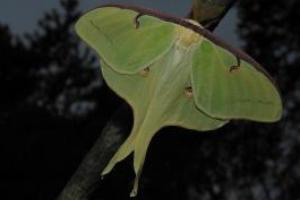Today the luna moth is featured in television commercials for a popular sleeping pill, and (somewhat absurdly) on cans of moth balls marketed to control moths that infest clothing.
Photo Credit: Damon Noe
Actias luna
Common Name: luna moth
Animal Guild: Insect
Class > Order > Family: Insecta > Lepidoptera > Saturniidae
What does the species look like?
Probably the most recognized moth in North America, the luna moth is easily recognized by the green color, large wing span of about 3-4 inches, long tails, and eyespot on each wing. No other species in North America remotely resembles a luna moth. The earliest spring adults are much brighter green than later adults. Females are lighter than males. In southern populations there is often a row of dark spots or a thin dark line on the forewing, as on the male illustrated here. The caterpillars are green with a brown head, but may become brown a day or so before they spin their cocoon. The body has a variable amount of sparse hairs (but no spines). Markings include a lengthwise yellowish line on each side and yellow between most of the segments, but no diagonal lateral (side) streaks. Caterpillars of the polyphemus moth are similar but have conpsicuous diagonal yellowish lines on each abdominal segment and they are usually found on oaks, maples, and willows.
Where is the species found?
States & Provinces
AL, AR, CT, DC, DE, FL, GA, IA, IL, IN, KS, KY, LA, MA, MD, ME, MI, MN, MO, MS, NC, ND, NE, NH, NJ, NY, OH, OK, PA, RI, SC, SD, TN, TX, VA, VT, WI, WV
Distribution
This species ranges from Nova Scotia to central Saskatchewan in Canada, south through eastern Texas, and most of Florida.
The luna moth is primarily a species of deciduous or mixed forests and hardwood swamps where its food plants grow. Although caterpillars do occur in suburban yards, cocoons in such places are likely to be removed when leaves are raked in the fall. Luna moths are common in most eastern forests, but might still be rare in some parts of New England, where these and many other large moths with summer caterpillars declined drastically or died out in the mid to late 20th century, probably due mostly to high mortality of larvae caused by an introduced parasitic fly intended to control spongy moth populations.
General Phenology and Life History
The phenology of this species varies regionally. All populations overwinter as pupae in silk cocoons in the leaf litter. There is one generation in Canada and in the northernmost U.S., with adults emerging in late May through June. In southern New England and southern Michigan there is a partial second brood some years. Two generations, perhaps a partial third, occur from central New Jersey and southern Pennsylvania, west through the Ohio Valley to Missouri, from about April to August. Three or more generations occur farther south where the first adults usually appear in March. Where there are two or three generations, the first spring adults usually appear when forest canopy leaves are expanding.|Adults emerge by early afternoon and females normally mate before midnight that night. Females often fly up into the canopy before releasing a pheromone to attract males. Undisturbed mated pairs often remain attached until the following evening. Females usually start laying eggs the night after mating and lay a few dozen each night for perhaps as long as a week. In warm summer conditions, eggs hatch in 9-11 days, caterpillars mature in about 3-4 weeks, and non-overwintering cocoons hatch in about 3-4 weeks. Thus a generation can be completed in about two months. Caterpillars feed mostly on white birch in the far north and hickories and birch in New England. Hickories (including pecan), walnuts, persimmon, black gum, and sweetgum are important foodplants farther south. Adults are usually seen on buildings near lights or flying about street lights. Newly emerged adults are sometimes found in forests in the afternoon and evening, and are most easily seen in spring when leaves are still small.
Which phenophases should I observe?
Do you see/hear...?
Activity
Adults More...
For abundance, enter the number of individual animals observed in this phenophase.
Reproduction
Mating For abundance, enter the number of individual animals observed in this phenophase.
Egg laying Actias luna , eggs are typically deposited on the underside of deciduous tree or shrub leaves.
For abundance, enter the number of individual animals observed in this phenophase.
Development
Caterpillars Actias luna , young caterpillars are bright green with rows of large, pale green dots bearing tufts of white or black-tipped hairs. Older caterpillars are bright green and the dots change to yellow, orange and then red, becoming increasingly smaller as the caterpillar gets larger with each molt.
For abundance, enter the number of individual animals observed in this phenophase.
Caterpillars feeding Actias luna , caterpillars feed on the leaves of trees and shrubs.
For abundance, enter the number of individual animals observed in this phenophase.
Dead adults For abundance, enter the number of individual animals observed in this phenophase.
Dead caterpillars For abundance, enter the number of individual animals observed in this phenophase.
Method
Individuals at a light For abundance, enter the number of individual animals observed in this phenophase.
Individuals in a net For abundance, enter the number of individual animals observed in this phenophase.
Individuals in a trap For abundance, enter the number of individual animals observed in this phenophase.
What do these phenophases look like?
There is currently no photoguide available for this species. If you'd like help us create one, use the guidance document and species template provided here . Then send it via email to education@usanpn.org when it is complete.
